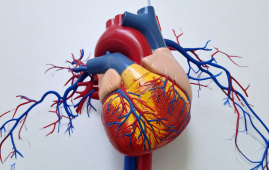

Using methods like functional magnetic resonance imaging, which maps the brain’s responses to input and activity, current approaches to autism research observe and understand the disorder through the study of its behavioral consequences. However, little work has been done to understand the causes of these responses.
“It hasn’t been well understood what those differences might be,” said Benjamin Newman, a postdoctoral researcher with UVA’s Department of Psychology, a recent graduate of UVA School of Medicine’s neuroscience graduate program, and lead author of a paper published this month in PLOS: One. “This new approach looks at the neuronal differences contributing to the etiology of autism spectrum disorder.”
Using the most recent neuroimaging data and computational techniques, Newman and his co-authors built on the work of Alan Hodgkin and Andrew Huxley, who were awarded the 1963 Nobel Prize in Medicine for characterizing the electrochemical conductivity characteristics of neurons. This allowed them to understand how conductivity varies between individuals with and without autism. As a result, a novel method for determining neuronal axon conductivity and information-carrying ability has been developed. Additionally, the study provides proof that the participants’ scores on the Social Communication Questionnaire, a widely used clinical instrument for autism diagnosis, are directly correlated with those microstructural changes.
“What we’re seeing is that there’s a difference in the diameter of the microstructural components in the brains of autistic people that can cause them to conduct electricity slower. It’s the structure that constrains how the function of the brain works.” Benjamin Newman, a postdoctoral researcher with UVA’s Department of Psychology
John Darrell Van Horn, a psychology and data science professor at UVA and one of Newman’s co-authors, stated that we frequently attempt to comprehend autism through a set of behavioral patterns that may be odd or appear distinct.
“But understanding those behaviors can be a bit subjective, depending on who’s doing the observing,” Van Horn said. “We need greater fidelity in terms of the physiological metrics that we have so that we can better understand where those behaviors coming from. This is the first time this kind of metric has been applied in a clinical population, and it sheds some interesting light on the origins of ASD.”
Although functional magnetic resonance imaging has been used extensively to examine blood oxygen-related signal alterations in autistic people, Van Horn noted that this research “Goes a little bit deeper.”
“It’s asking not if there’s a particular cognitive functional activation difference; it’s asking how the brain conducts information around itself through these dynamic networks,” Van Horn said. “And I think that we’ve been successful showing that there’s something uniquely different about autistic-spectrum-disorder-diagnosed individuals relative to otherwise typically developing control subjects.”
The primary investigator of the study, Pelphrey, is a neuroscientist with expertise in brain development. The main goal of the ACE project is to set the standard for the development of a precision medicine approach to autism.
“This study provides the foundation for a biological target to measure treatment response and allows us to identify avenues for future treatments to be developed,” he said.
According to Van Horn, there might be ramifications for the investigation, diagnosis, and management of several neurological conditions, such as Parkinson’s and Alzheimer’s.
“This is a new tool for measuring the properties of neurons which we are particularly excited about. We are still exploring what we might be able to detect with it,” Van Horn said.
For more information: Conduction velocity, G-ratio, and extracellular water as microstructural characteristics of autism spectrum disorder, PLOS ONE, https://doi.org/10.1371/journal.pone.0301964h
more recommended stories
 Citrus and Grape Compounds Help Prevent Type 2 Diabetes
Citrus and Grape Compounds Help Prevent Type 2 DiabetesA new clinical trial highlights the.
 Personalized Pain Care Transforms Parkinson’s Treatment
Personalized Pain Care Transforms Parkinson’s TreatmentNew UniSA research underscores the urgent.
 Genetic Diversity Explains Obesity Risk Differences
Genetic Diversity Explains Obesity Risk DifferencesCross-ancestry Study Identifies Novel Obesity Genes.
 Meniscal Tear and OA Pain Improved by Home Exercise
Meniscal Tear and OA Pain Improved by Home ExerciseHome Exercise Proves Effective for Knee.
 AI ECG Model Outperforms Standard STEMI Triage
AI ECG Model Outperforms Standard STEMI TriageNovel AI ECG Model Outperforms Standard.
 New Software Transforms Real-Time Pathogen Surveillance
New Software Transforms Real-Time Pathogen SurveillanceReal-Time Pathogen Surveillance Software Transforms Environmental.
 Bright Nights May Increase Stroke, Heart Failures in Adults
Bright Nights May Increase Stroke, Heart Failures in AdultsBright Nights are tied to increased.
 Cannabis Use Linked to Regular Tobacco in US Youth
Cannabis Use Linked to Regular Tobacco in US YouthCannabis Use and Tobacco Risk: A.
 Mediterranean Diet Reduces Endometriosis Risk in Women
Mediterranean Diet Reduces Endometriosis Risk in WomenMediterranean Diet and Endometriosis: A Promising.
 Night Shifts May Trigger Irritable Bowel Syndrome (IBS)
Night Shifts May Trigger Irritable Bowel Syndrome (IBS)Night Shifts and Digestive Health: Linking.

Leave a Comment